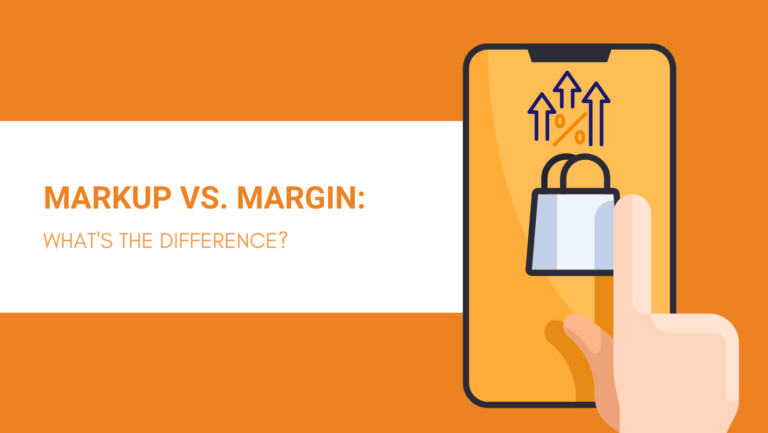Markup and margin are common accounting terms that are often used when pricing your products.
Many people think they’re the same and use them interchangeably, however, that is a misunderstanding.
There’s a distinct difference between the two terminologies.
Simply put, markup is the amount by which the product cost is increased to get the selling price.
While margin is the difference between the selling and the sourcing price.
If that sounds too confusing then don’t worry.
In this article, we’ll go over the main differences between markup vs. margin, discuss how to calculate them and much more.
So let’s get started!

What Is Markup?
Markup is the amount by which the cost of a product is increased to get its final selling price.
Let’s say you’re sourcing products at $30/unit and then increasing the price to sell them at $50/unit.
In this case, a markup of 20$ yields the $50 price which is about 66.7% markup.
This markup percentage is calculated by dividing the added cost by the sourcing cost and then multiplying the resultant with 100.
What Is Margin?
Margin is the difference between the sourcing price and the final selling price of the product.
So if you’re selling a product for $50 and its sourcing price is $30, then your margin would be $20, which equals 40%.
The Difference between Markup and Margin
After going through the definition of markup and margin, it makes sense why people get confused between the two.
Let’s just say that the key difference between markup and margin is that the markup is the added cost of the product on top of its sourcing price. While margin is simply the difference between the final selling cost of the product and its sourcing price.
So by using the examples from above, if you’re sourcing a product for $30, and plan to keep a 40% margin, you’ll have to set the final selling price at $50 – which is a 66.7% markup.
If that sounds confusing then don’t worry because in the next section we’re going to explore how markup and margin are calculated.

How to Calculate Markup and Margin?
If you want to calculate your markup percentage, then divide the markup amount by the cost of the product and multiply the result by 100.
You can calculate the markup percentage by using the following formula:
Markup % = (Added Cost/Sourcing Cost) * 100.
If we once again refer to the example above, then let’s plug in the sourcing cost which was $30, and added the cost of $20 to the formula:
Markup = (20/30) * 100 = 66.7%.
This proves that if you’re sourcing a product for $30 and selling it for $50, you’re keeping a markup percentage of 66.7%.
Similarly, the way to calculate margin is by subtracting the final selling price of the product from its sourcing cost. Keep in mind that margin is always calculated in percentage.
The formula for calculating the margin would look something like this:
Margin = ((Final Price – Sourcing Price) / Final Price) * 100
Now, let’s apply the formula for margin to the sample example where the final price is $50 and the sourcing price is $30:
Margin = ((50 – 30) / 50) * 100 = 40%
In case mathematics isn’t your favorite subject, the reason we’re multiplying by 100 is to calculate the percentage.

Markup and Margin Chart
Markup and margin are closely linked, so it isn’t surprising that they also interact predictably. If you know the value of one, then it isn’t difficult to calculate the other.
But if you want to avoid the hassle altogether then here’s a chart with some of the most common markup vs. margin rates:
| Markup | Margin |
| 11% | 10% |
| 18% | 15% |
| 25% | 20% |
| 33% | 25% |
| 43% | 30% |
| 58% | 35% |
| 67% | 40% |
| 82% | 45% |
| 100% | 50% |
Note: All of the markup percentages have been rounded from decimals to their nearest whole numbers.
How to Convert between Markup and Margin
We just mentioned that markup and margin interact in a predictable manner and it’s possible to determine the value of one, by knowing the other – so how can you do that?

Well, let’s look at some formulas that will help you convert between markup and margin.
Markup to Margin Conversion
You can use the following formula to convert markup to margin:
Margin = (Markup / (1+ Markup)) X 100
Let’s refer back to the example we’ve been using since the beginning of this article. Remember how we calculated a 67% markup for a margin of 40% that you can also verify in the chart?
Well, we’re going to use the same values to show you how this formula works:
Margin = (0.67 / (1 + 0.67)) X 100 = 40%
The result we now have certainly looks familiar, doesn’t it? The only thing we did was to round the answer with the closest whole number.
Margin to Markup Conversion
The formula to convert margin to markup is quite similar to the one we just discussed above. You just have to replace markup with margin and change the plus symbol into a minus:
Markup = (Margin / (1 – Margin)) X 100
It’s now time to take this formula for a spin, and for that, we’re going to go back to our favorite example (you’ve probably memorized those values by now).
So let’s take the 40% margin that we calculated for a 67% markup and plug it into the formula:
Markup = (0.40 / (1 – 0.40)) X 100 = 67%
See how this formula brings us back to our calculated markup percentage? Well, that’s all you have to do to convert margin into markup.
When to Use Markup/Margin?
You should use markup percentage when you’re trying to decide the selling price of your products.
Deciding the markup percentage is a complicated step and depends on a variety of factors like the manufacturing/sourcing price, product quality, and competition.
Margin can be used to assess the performance of your store and the amount of profit you’re potentially making.

How to Calculate Markup/Margin on Products
Calculating the markup/margin on products depends on a variety of factors. So let’s shed some light on those:
1. Type of Business
Your markup/margin percentage has a lot to do with the type of business you’re operating.
For example, if you’re running a wholesale business then you would be expected to keep a lower markup, which is around 18—25% which approximately equals to a margin of 15—20%
The reason behind that is that you’ll most likely be selling the products in bulk.
Similarly, if you’re running an eCommerce store and using a fulfillment method like dropshipping then you have to be smarter about your pricing. You can learn more about that by checking out our Dropshipping Profit Margin guide.
Ultimately, there isn’t a one-size-fits-all strategy when setting the markup for your product. You have to experiment according to the type of your business to figure out what works best for you.
2. Past Experience
You can pretty much sell your products at any price you want. The question is – would anyone buy them unless you have the credibility to back up those prices?
So the percentage of the markup/margin you keep also heavily depends on your experience.
We would suggest new entrepreneurs shoot for a lower markup to build a solid customer base first.
If you don’t want to do that, then you can at least consider offering a discounted price to tempt the customers to try your products.
Either way, unless you have an established brand identity or at least some proven track record in the industry, you’ll have a hard time getting away with high initial prices.
That’s why your main focus at the start needs to be a lower markup, so you can compete against already existing and established brands.
3. Competition
Unless you have a monopoly over a product, there’s a certain limit to the amount of markup you can set.
That percentage is usually derived from the average of your competitors.
If you and your competitors are selling the same product, then just compare the price and set your markup somewhere close to that.
And if you’re setting a higher markup than your competitors, then be sure to back that up with superior product quality.
Overall, market research is an important approach for the success of any business.
4. Supply Chain
It’s important to consider your supply chain while setting the markup price.
Even if you’re sourcing the product at a low price, it’s pointless if all your revenue is getting drained by the logistical costs.
This is in fact a common mistake that new entrepreneurs make.
They get so invested in the sourcing cost that they completely disregard the other expenses that come while running a business.
So make sure that the selling price of your product at least covers the operational costs of your business.
And in case you aren’t able to resolve the supply chain issues, we would recommend getting the assistance of a professional product fulfillment service.

5. Marketing
In today’s world, there are countless ways for you to market your business. Some of the most common are dropshipping marketing, social media marketing like Tiktok, Shopping ads, or getting the help of influencers with Instagram shoutout.
The point is, you can spend millions of dollars on marketing your business, or only a few hundred bucks – there’s no limit.
We recommend setting your markup price according to the amount of money you plan on investing in marketing.
Otherwise, getting sales is pointless if all your money is going towards marketing and you’re sitting with little to no profit.
Even if you’re going for an aggressive marketing strategy and investing all your money into it, make sure to have a long-term plan. And most importantly, know the audience you’re trying to target.
Once you start getting more customers and your brand is recognizable, start slowly increasing your markup over time.
6. Product Type
The type of product you’re selling also plays a major role in determining the pricing window.
For instance, you can’t set a 300% markup if the only thing you’re selling is potato chips.
This is also one of the reasons why planning the markup isn’t the only thing you have to worry about.
If you’re planning to launch an eCommerce store, then the most important aspect is product hunting – which is a comprehensive topic that we’ve already covered in another article.
So to keep it short, if you have a set percentage of markup in your mind, then make sure to look for a product that lets you get away with it.
FAQs about Markup and Margin
Is There a Difference between Profit and Margin?
The subtle difference between profit and margin is that the former is measured in dollar terms while the latter is always in percentage.
Other than that, both profit and margin are relative in context as they help measure the amount of money a business is generating after the sourcing/operational expenses.

Can Markup and Margin Be Used Interchangeably?
No, markup and margin and two different terminologies. While they interact predictably, they cannot be used interchangeably. However, you can use the value of one to calculate the other.
Markup vs. Margin, What to Use for Determining Selling Price?
Markup is generally used to determine the selling price of a product. Margin, on the other hand, is used to evaluate the financial performance of a business and the amount of money you’re making on each sale.
Summary
Every business owner needs to understand the difference between markup and margin. It’s an important part of pricing your products.
Throughout this article, we’ve shared several examples that will help you learn how these terminologies differ from one another.
Just keep in mind that whenever you’re sourcing products, your main goal should be to get a mix of both quality and price.
So if you want any help regarding product sourcing then you can contact NicheDropshipping to get a free quote today. We are experts at negotiating the best possible sourcing price to improve your profit margin.

